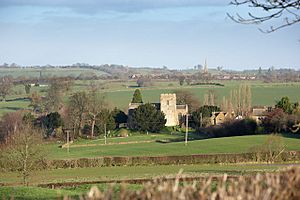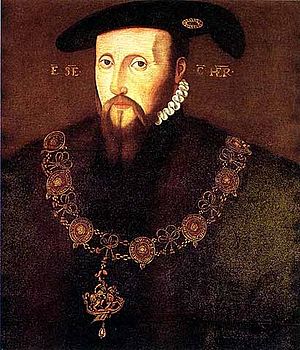Buckinghamshire and Oxfordshire rising of 1549 facts for kids
The Buckinghamshire and Oxfordshire Rising of 1549 was a protest by people in the countryside of Tudor England. It happened when Edward VI was king, and his special helper, Edward Seymour, 1st Duke of Somerset, was in charge.
This protest was one of many that happened across England in 1549. It took place at the same time as the famous Prayer Book Rebellion in the west of England and Kett's Rebellion in the east. People were unhappy for many reasons. They didn't like the new Book of Common Prayer, which changed church services from Latin to English. They also faced money problems and were angry about "enclosures." This is when common land, which everyone could use, was fenced off by rich landowners. This time was known as "the commotion time" because of all the unrest.
Contents
Who Led the Protest?
It seems that James Webbe, a church leader (vicar) from Barford St Michael, was a main leader of the protest. Other important people were Thomas Bouldry, a rich farmer from Great Haseley, and Henry Joyes, another vicar from Chipping Norton.
Unlike other protests, no rich landowners (gentry) seemed to join this one. Most of the people involved were farmers, craftspeople, or local priests. We don't know exactly what the protesters wanted because the protest was stopped so quickly. But they probably wanted similar things to the Cornish protesters. This included bringing back the old Latin church services and the Six Articles, which were old religious rules.
Henry Joyes, the vicar from Chipping Norton, joined because a new law about churches (the chantries act) meant he had to look after 800 people all by himself.
Why Were People Angry?
People were also angry about land being "enclosed." This was especially true in Great Haseley, where Thomas Bouldry lived. Protesters attacked the deer park of Sir John Williams at Rycote House. They broke into his house and drank his wine and beer. There had been smaller land protests in Buckinghamshire the year before, but the government had been quite gentle then.
The first clear sign that the government was reacting was a letter from Lord Protector Somerset on July 10. He mentioned people "newly assembled" in Buckinghamshire. Two days later, he told another leader, Lord Russell, about a "stir here in Bucks. and Oxfordshire by instigation of sundry priests."
How the Protest Was Stopped
The protest grew bigger. In mid-July, soldiers were sent to stop it. They were led by a strong soldier named William Grey, 13th Baron Grey de Wilton. With him were 1500 soldiers from Germany and Switzerland. These soldiers were actually on their way to stop the protests in the west of England.
It's often thought that Lord Grey's soldiers met the protesters at Enslow Hill in Oxfordshire. But some people think the meeting happened near Chipping Norton. After the soldiers arrived, some people in the government worried about using foreign soldiers. There were reports that people were threatening to kill any foreigner in England.
What Happened Next?
Lord Grey gave orders on July 19 that many protesters should be killed right away without a trial. About 200 people were captured. Around a dozen of the main leaders, including priests and farmers, were ordered to be executed for treason in different towns. Their executions were planned for market days, and their heads were to be put in high places to scare others.
James Webbe was executed in Aylesbury on August 22. Henry Joyes was hanged from his own church tower. Thomas Bouldry and others were also executed. However, not everyone ordered to die was killed. For example, John Wade, a vicar, was spared. Some men from Buckinghamshire were also pardoned.
Even with some pardons, the protest was put down very harshly, just like the Prayer Book Rebellion. Lord Grey was known for being severe, and it seems many more people were executed than the dozen mentioned in his orders.
The many protests across England in 1549 played a part in Lord Protector Somerset losing his power later that year. Other government members blamed him for the unrest. They also criticized him for how he handled the protests, which sometimes seemed too kind and other times too cruel. Somerset seemed to have some sympathy for those protesting against enclosures. Many people who pulled down fences believed they were doing what the King wanted because of Somerset's earlier statements. Somerset was disliked by those who wanted to keep the old religious ways. When he was finally removed from power in January 1550, people in Oxford celebrated.
Remembering the Protest
The Buckinghamshire and Oxfordshire Rising was not well recorded and was almost forgotten, even in official papers. However, people in the local area remembered it. Fifty years later, stories about how it was stopped helped inspire another protest, the Oxfordshire Rising of 1596. The leader of that protest, Bartholomew Steer, told his followers to meet on Enslow Hill. He said that in 1549, the protesters there were told to go home and then "were hanged like dogs." Even though the 1549 protest happened before Steer was born, he might have heard about it when he worked at Rycote. Also, the priest from his hometown was hanged after the events of 1549.
Historians have different ideas about the protest. Some, like A. Vere Woodman, thought it was mainly about religious changes and church property. Others, like Beer, have focused more on the anger about land enclosures.



